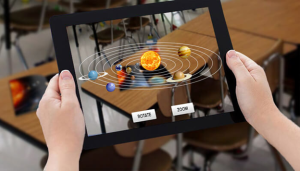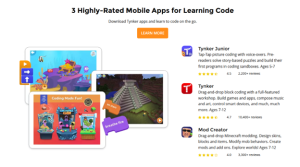Augmented Reality is a thriving technology that has opened up floodgates of exciting opportunities for various sectors. From eCommerce to healthcare and media to education, AR is now everywhere, making our lives convenient and comfortable.
When it comes to education, Augmented Reality has been a path-breaker in the sense that it facilitates remote learning and provides students with a different kind of learning experience.
As per Statista Report on e-learning, the market size worldwide is expected to reach 400 million USD by 2026, which is a staggering rise from 200 billion USD in 2019. Likewise, it is also estimated that mobile users using Augmented Reality (AR) will reach nearly 2.4 billion by the end of 2023.
In 2015, only 2 million users were taking the advantage of this cutting-edge technology. This outstanding influx in numbers cannot be ignored and here, in this article, we are going to unfold the reason behind its soaring popularity and how it is transforming the education sector.

Are you excited to learn? Let’s get started.
Table of Contents
Chapter 1: The Technology of Augmented Reality Explained
Definition of Augmented Reality
Augmented Reality is a new-age technology that augments images, sounds, text, etc in a digital world and creates a real-life environment. It superimposes or overlays computer-generated images into the physical world and gives the users a highly enhanced and interactive experience.
Augmented Reality is different from Virtual Reality because the latter creates a whole-new cyber or virtual world for the users, whereas the former adds digital elements to our existing world.
Online retailers and businesses from other industries are leveraging this breakthrough technology combined with Artificial Intelligence solutions to promote their products/services, strengthen their marketing campaigns, and gain customer insights.
However, AR in education is beneficial in enhancing the learning abilities of students and helping educators increase student engagement. Moreover, e-Learning solutions powered by AR help in effective learning, lowering costs, and improving user engagement.
Let’s get into the details of the areas where Augmented Reality is streamlining the learning process and helping the education sector thrive faster.
Overview of Augmented Reality in Education
To be precise, the technology of AR is playing an integral role in providing an interactive learning experience. AR simplifies complex subjects and makes them easy to understand with the help of three-dimensional models. Thus, students are now able to comprehend the concept in a more simplified manner.
AR is explored and utilized by the education industry also for training purposes where it merges information and objects to create an augmented learning environment. For this reason, students from all educational domains like science, arts, medicine, geography, etc. are eager to learn new topics realistically through AR.
Importance of AR in Education
Learners and educators from all parts of the world are appreciating this revolutionary technology as it promises to increase their knowledge through conceptual learning, the creation of real-life scenarios, engaging content creation, numeric calculations, spatial concepts, and playing.
For instance, it is really hard for medical students to understand the cardiovascular system, pulmonary system, and neural pathways through lengthy and detailed passages in a textbook. So, when AR comes into the scene, the process of learning becomes smooth as a cakewalk. The 3D models of human anatomy help the learners visualize where the heart is located, the flow and direction of pulmonary veins, and so on.
The above example is a real use-case of AR in the medical field of the education sector. Apart from this, the other importance of AR in education is summarized in the below points.
- It increases the learning time of the students by making subjects more interesting compared to the 2D teaching approach.
- It improves the problem-solving skills of the learners and motivates them to perform better by enhancing their learning experience.
- The live or 3D examples help students uncomplicate the tough concepts and topics.
- It turns a regular classroom education into a more engaging session where educators enjoy teaching and learners enjoy learning.
Chapter 2: How AR is Transforming the Learning Experience
AR has secured its position in the education sector as a primary tool for learning by blending real-world visuals with digital software to produce a simulated environment. Whether it is preschools, grade schools, high schools, or colleges, everyone is making the most of this game-changing technology to give their students an immersive learning experience.
Let us check the diverse ways Augmented Reality impacts learning.
Interactive Learning
AR has the potential to redefine learning by making it interactive with the use of 3D models. It enhances visualization and eases the understanding of abstract or complicated concepts. Further, it provides conceptual learning by superimposing information on top of real-world objects. Thus, it lets the students relate the concept to a real-world situation.
Most importantly, AR allows learners to concentrate on practical lessons instead of relying on just theories. Another interesting way AR makes the learning journey interactive is by facilitating collaborations. It enables learners to work and study together with other learners in a shared AR experience. This promotes teamwork and enhances social learning.
Increased Engagement
The first point brings us to the next benefit of AR in education which is increased engagement. Through gamification and multi-sensory learning, AR helps learners engage deeply with the study material and enhance retention. Rather than merely reading textbooks or listening to lengthy 1-hour lectures, AR-enabled content helps students gain knowledge by immersing themselves in the subject matter and visualizing results,
Practical learning is what AR focuses on and students, instead of reading long texts can now see everything in action with their own eyes. In addition to this, introducing games makes the learning process fun and encouraging. Students are motivated to actively participate in the process and learn new things while enjoying the games. Multi-sensory learning incorporates visuals, audio, and tactile feedback.

Improved Retention
The easiest explanation for this is that Augmented Reality makes the learning experience memorable for the students which improves retention. AR has made us realize education can go beyond textbooks and can engage multiple senses which improves memory recall. This process of multi-sensory learning helps the students absorb information more effectively.
In addition to this, AR can be used to cultivate interest in students, especially kids in grade schools and high schools who are mostly fickle-minded, lack seriousness in their studies, and forget lessons. With AR, knowledge retention becomes easy and even a dull student can learn fast and stay on par with the other intelligent kids in the class.
Personalized Learning
Personalized learning has a great impact on a student’s life because it not only improves her performance but also transforms the course of her entire learning journey. We all know that every child is different and needs separate kinds of attention when it comes to learning and imparting education.
Everyone does not learn the same way and hence, personalized learning using Augmented Reality can help to cater to the individual needs of the students. It removes barriers between students and content by helping them interact with the content virtually through 3D objects. Personalized learning through AR promotes critical thinking and creativity by encouraging students to think outside the box, make mistakes, and learn from those mistakes.
Real-World Applications
Augmented Reality is more and more used by educational institutions to provide learners with new perspectives and help teachers their students more effectively by incorporating multimedia and 3D visuals into their lessons.
Applications of AR in different areas of education have been incredible. These real-world use cases of AR present a spectacular opportunity to increase the knowledge base of the students. A comprehensive insight into the real-life examples of AR-based education mobile applications is provided in the next chapter.
Chapter 3 – Examples of AR in Education
AR in Classroom Education
AR allows teachers to represent the learning material virtually to the students and make the classroom learning experience thrilling. Not only teachers can explain the topic more clearly but also it prevents distraction among students like in regular classroom sessions.
You can build on-demand tutor apps integrated with AR technology for almost every subject like science, history, social studies, grammar, and even programming. Let’s take a look at some of the top popular applications.
Quiver Vision – The Quiver education app is a 3D coloring app that animates the images one draws and colors on paper. It creates colorful experiences for kids who want to make their masterpieces move and run wild.

Arloon Chemistry – Like the app says – “Transform your table into a virtual laboratory!”, Arloon Chemistry makes students fall in love with chemical formulas, periodic tables, etc. Students can observe molecules and salts in 3D and can experiment with them freely through practices online to create compounds.

AR in Medical Education
There is no denying that the human body and its functions are super-complicated. Hence, the process of learning and training medical students and staff involves a lot of dedication and hard work.
However, AR has streamlined the learning journey by creating 3D models of the human body to help students learn anatomy in detail.
Some of the best examples of Augmented Reality in medical science are –
Human Anatomy Atlas – An AR-based app that shows a 3D human body that allows the students to explore and learn about the body parts, organs, nerves, etc.

HoloAnatomy – This is another application that allows medical students to study the human body in an innovative manner i.e. by interacting with 3D models.
Touch Surgery – Earlier, student surgeons had no other way to enhance their surgery skills before conducting a real surgery. But now they can! With Touch Surgery, they can practice surgeries on 3D body parts.
AR in History
Now teachers of history can also take the advantage of AR to help students time travel to ancient historical sites. Can’t believe this? Well, it is true. AR tools like Timelooper and 360Cities, educators can take their students on virtual site tours of historical and cultural places around the world.
Additionally, when schools and colleges take their students on excursions to museums and historical sites, they can use AR apps on their smartphones to get valuable information and context about the artifacts they see. This interactive learning deepens a student’s understanding of historical perspectives and they won’t find the subject of history boring anymore.
AR in Coding
You will be amazed to learn that AR can also be used to teach coding to kids and teenagers. Tynker is one such application that provides a variety of tools to the teacher to develop lesson plans for coding and enable students to create their AR classroom projects.
The platform offers three different kinds of apps for learning codes for kids of all age groups. Kids solve puzzles, drag-and-drop block codes, create mods, and much more to build programs.

AR In Professional Training
Industries like Aerospace, military, aviation, hospitality, and others are also investing in AR to make the training processes interactive and reduce expenses on equipment.
A NASA project called Sidekick provides instructions virtually along with creative illustrations through Hololens in crew training. This project not only prevents the soldiers from facing dangers but also helps them get trained with efficiency and ease.
Chapter 4 – Advantages and Challenges of AR in Education
Advantages
There are several perks of Augmented Reality in the education sector out of which the three most sought-after benefits. Let’s discuss those advantages one by one.
Improved Learning Outcomes
AR allows learners to gain knowledge through interactive 3D visuals of the subject matter. It lets them immerse themselves in a topic. Their interest levels can be increased by encouraging participation through gamification, quizzes, and contests in the AR environment.
This pioneering technology allows educators to build exciting virtual environments for the learners to teach new concepts, instill their interests, and develop new understandings. Especially, when a particular subject or topic bores your kids, you can use AR in classroom education to make it engaging and enjoyable for them. This way AR improves learning outcomes by helping students learn faster and more effectively.
Cost-Effective
Cost is considered the biggest barrier to incorporating practical learning in educational institutions. Setting up laboratories, buying equipment, hiring lab resources, organizing historical site tours, etc. all involve a lot of expenses. As a result, students’ learning experiences are confined to textbook knowledge.
However, with the advent of AR technology, educators can give their students practical lessons at zero cost. Since most platforms are accessible from either websites or mobile apps, no hardware installation is required to run AR apps. Students can easily indulge in an immersive learning process from their smartphones.
Better Access to Learning Materials
With the help of AR, teachers can create high-quality and informative digital content for their students. They can converge 3D images into the real physical world and create learning materials that are easily accessible to students anytime, anywhere.
You just need a smartphone with a stable internet connection to reap the fruits of AR-powered learning materials. Most importantly, it replaces physical textbooks, printed forms, and hand-made posters to provide lessons to students. mLearning applications integrated with AR reduce expenditures on physical study materials and promote remote learning.
Challenges
Although Augmented Reality offers a plethora of benefits to the education sector, some drawbacks sometimes hinder the implementation of this technology in education. Let us see what challenges are faced by educational organizations in integrating AR.
- Technological Limitations: As said earlier, AR is a next-generation technology that superimposes computer-generated images in the real world. This means one needs to possess a fully-functional smart device such as a mobile phone, tablet, laptop, etc. which must be backed by a steady internet connection. A smartphone with no internet connection is completely useless for a student who wants to explore the world of AR in education.
Also, another technology limitation that AR developers often face is device portability issues. The content or AR model created needs to work responsively and effectively on all types of platforms and devices. A developer’s experience might vary from device to device or platform to platform.
- Integration with Curriculum: Another complication that often educational institutions face is integrating AR learning into the school curriculum. It is a type of practical learning session where students interact with 3D images and collaborate with other students to participate in interactive learning programs.
Therefore, it becomes difficult for the teachers to assess the performance of the students and give them marks just like they do in exams. The institutions and educators still struggle to find answers to questions like how to incorporate AR learning materials in a school syllabus or curriculum and how much time should be appropriate for the students to dedicate to such activities.
- Teacher Training and Support: Well, you need to accept the fact only tech-savvy teachers can implement and handle Augmented Reality in education. Although young and modern-day teachers can easily acquire new skills to operate AR apps, teachers who are aged and are accustomed to using smart devices will have some real hard times with these applications.
Most institutions need to hire tech professionals to provide teacher training and support so that teachers can easily learn this cutting-edge technology. This is both costly and time-consuming.
Chapter 5 – The Future of AR in Education
Considering the line of benefits AR offers and its endless list of use cases, it can be said that the future of AR in education is quite promising. The other emerging possibilities of AR are as follows:
Distance learning – AR makes it possible for students to learn and acquire knowledge without visiting the school or getting a teacher. AR-aided learning provides tremendous scope for education to those with physical disabilities, geographical restrictions, and others. They can get a virtual teacher anytime to get an intuitive learning experience.
In-work training – Organizations and companies use AR to teach their staff especially and help them acquire new skills and learn new ways in real-world scenarios.
Potential Impact
Integration of AR in education encourages active learning because it allows students to discover, explore, and interact with virtual objects in real-time. Thus, complex concepts become easier to comprehend.
AR has incredible potential to revolutionize the way teachers teach and learners learn. Personalized learning which earlier seemed like a distant dream is now a reality. Adapting to different learning styles catering to individual needs and capabilities will help students reach their learning goals faster.
Chapter 6 – Conclusion
Recap of Key Points
It would be wrong to say that Augmented Reality would completely replace traditional classroom learning. But it has definitely created a mixed ecosystem where technology blends with conventional methods of teaching to give students a highly-immersive learning experience.
Here’s a rundown of the sections we covered in the article in a few sentences.
- Augmented reality enhances learning experiences by creating interactive 3D
- AR makes education readily accessible to students from anywhere anytime.
- It is a cost-effective tool leveraged by educational institutions to upgrade their present teaching systems.
- It makes learning fun, promotes collaborative learning, and increases student engagement.
Final Thoughts on AR in Education
Our future of learning relies on a mixed ecosystem where both AR technology and traditional classrooms will go hand in hand. Instead of attending boring and monotonous lectures, students can enjoy hands-on learning with AR applications and website development.
Views: 707



 India
India
 United States
United States
 Kuwait
Kuwait

